“Birds of a feather flock together,” is a saying that applies to ornithologists as well as their subjects. Dick’s and Frank’s interest in birds began as boys and brought them together to study the birds at Hubbard Brook. These two ornithologists didn’t fit the common stereotypes of bird watchers. Dick’s six feet eight inches had him ducking under doorways. You would guess his hands handled a football or basketball rather than twenty-gram red-eyed vireos. Frank didn’t fit the tennis-shoe bird-watching cartoon version either. Only the binoculars around their necks, the bird guides in their pockets, and their topic of conversation identified them as birders. When they weren’t looking directly for a bird, they were always listening. Even in the middle of a “non-bird” conversation a birder noticed a singing whitethroat or catbird.
From birds the interests of the ornithologists had broadened to include ecology. So they had designed a study that would show the interrelationships of birds to their environment.
The ornithology crew’s morning started the evening before, when they listened to the weather forecast. Rain meant no netting. Birds trapped and made inactive in a net might die from exposure in a few minutes. Birds lose body heat when they can’t move and generate heat by expending energy. When it’s very cold, you shake, shiver, and hop around to keep yourself warm. Movement makes your heart beat faster and your blood flow faster, warming you. Or you put on a heavy coat to trap your body heat in the air next to your skin in order to keep warm. A bird’s feathers trap its warmed body air just as your coat traps yours. But when rainwater replaces the air next to its skin, a bird loses its body heat rapidly. Wet and immobile in a net, a bird can die from exposure very quickly.
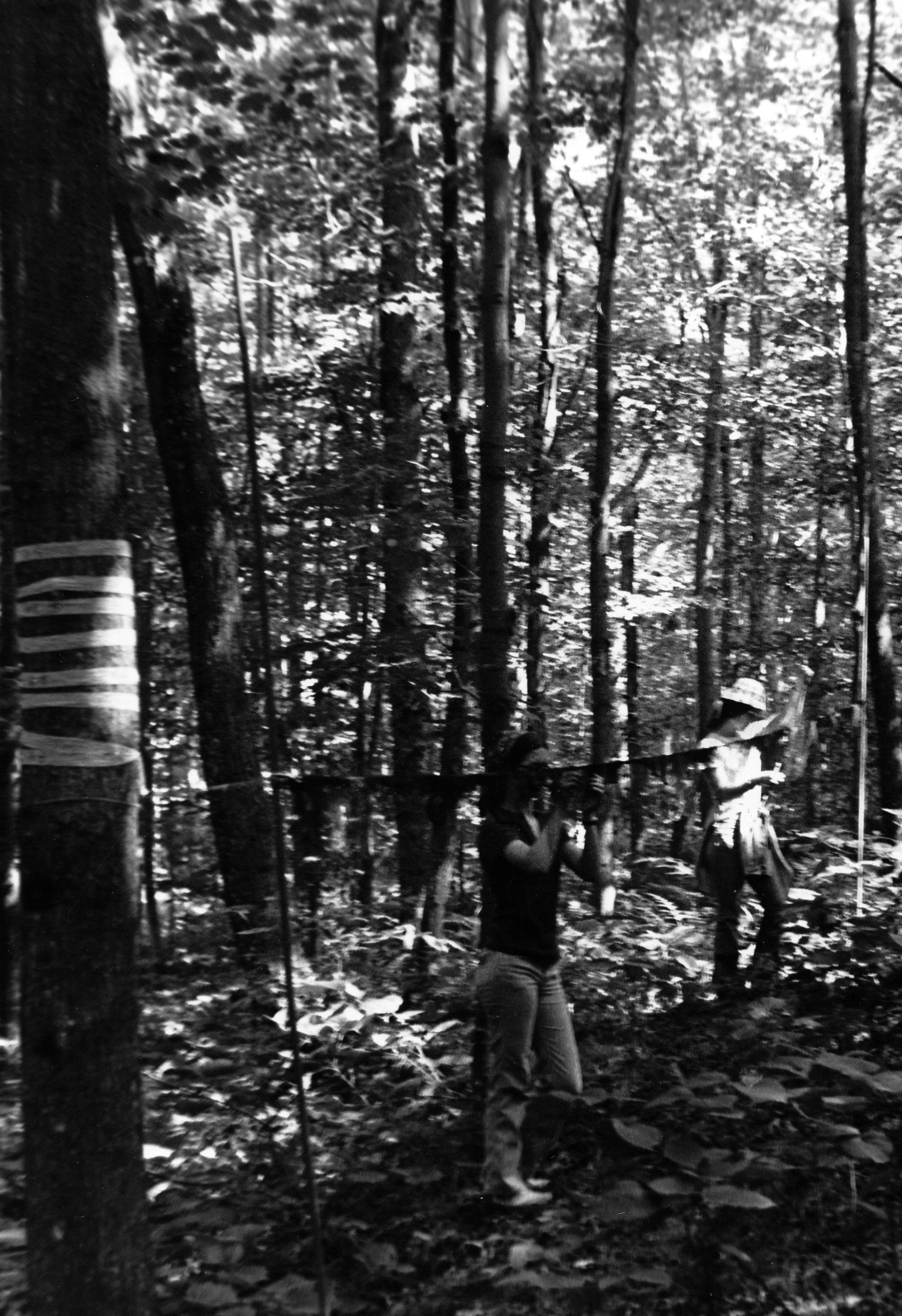
If the weatherman forecasted a clear day, netting and observing on the plot followed.
“Early birds catch the worm,” and early “birders” catch the birds. The height of bird activity is before noon. By the time the sun is high and the earth warmed, most birds become less active, awaiting the cooler evening.
Birder alarm clocks rang at five thirty A.M. one typical June day. By six A.M. the crew had finished breakfast, packed their lunches, pulled on their boots, hooked binoculars around their necks, and slipped on long-sleeved shirts or jackets to keep off the early morning chill and biting insects.
Dick warmed up the motor of the green carryall truck. Frank got in with two bags, each outfitted with color bands, metal Government bands, banding pliers, weighing scales, baby socks, bird guides, and recording books and sheets.
Dot, Dave Z., and Tom S. slid in. Tom and Dave, bird watchers of long standing, were quick and eager to learn anything new, and observed birds as much as they could. Dot’s nature interests were more recent, but she was ready to tackle anything on her way to becoming a biologist.
After fifteen minutes and three miles of narrow, curvy, unpaved road, the truck’s steep climb through dense forest and undergrowth stopped abruptly. A wall of forest rose immediately in front of the bumper. Their bird plot was just outside this watershed, number 6.
Dick and Frank had chosen this spot because the conditions were most like Watershed 6, where many plant and waterflow studies were being done. Nearby, the ornithologists could use the results of these studies, while their activities would not interfere with the Watershed 6 study results.
The ornithologists had measured the 10-hectare plot (almost 25 acres) off into 40 squares of about one quarter hectare each. Imagine one-inch squares on graph paper. Now increase the size of the squares to 50 meters (about 165 feet or 55 yards) on each side. At each corner of the quarter-hectare square was a tree wound with a strip of orange plastic tape. A net number was engraved on a metal tag and tied to the orange marker. Near each orange-marked tree and at each corner of the quarter-hectare square, a black net was stretched between two metal poles. Midway between the orange-marked trees, a tree was wound with a yellow plastic strip. The yellow and orange markers guided the researchers to the nets. It was easy to miss seeing a net and get lost in the woods. Up and down weren’t dependable guides in this mountain range. You could go down one ridge and up another without meeting a road. The leaves filtered light, making it more difficult to tell time or direction by the sun.
The ornithologists were trying to discover what kinds or species of birds were in their plot and how many individuals of each species were present. Like the other researchers, they carried around a whole list of questions in their minds. How many males and females of each species were in the plot? How many nesting pairs were there? In a nesting season, how many broods of young would each pair raise? What was the territory of individual birds and nesting pairs? How large were territories? Which individuals would return to the plots after migration and a nine-month absence? What was the survival rate for each species? What did the birds eat and what predators ate them? Just where were birds linked in the food chain and what was their role – the part they played – in the community life of the forest? After these questions were answered, the ornithologists knew there would be others.
How much of the forest energy rested in the birds? How much of the forest’s ecosystem energy did the bird population use? How much of the forest’s materials and energy moved into and out of the forest ecosystem through these birds? Did the birds control the insects in the forest or did the number of insects control the number of birds? How did the number of species and quantity of birds found in the cut areas compare to those in the forested area?
Each day’s work would bring pieces of the answers to the many questions. Which pieces could never be predicted exactly. How many and which unmarked birds, repeats (birds already banded), or species new to their nets would be caught each day? These were questions that could be answered by midafternoon.
Each day assignments were given out: Dick and Tom would do the census first. Then Tom would do a “wander mapping,” while Dick captured birds just outside the plot’s boundary for energy experiments.
Dave and Dot would handle C and D lines of nets, while Frank ran the lower A and B lines.
Insect repellant was passed around. The odor of the sticky liquid helped ward off black flies, mosquitoes, and no-see-ums that crept into hair and made large welts on the backs of hands and necks – any exposed skin.
Everyone walked rapidly into the cool shade of the forest.
The first thing netters must do is open the nets. Between eight-foot-tall silvery metal poles one inch in diameter a net was wound into a thick black rope. As Dave and Dot unwound the net, a black hammock appeared and then a nearly invisible black badminton-like net stretched taut and covering all the space between the poles to the forest floor.
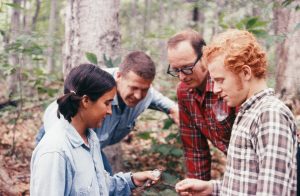
It certainly would save effort and time not to open the nets each morning and close them before leaving the forest. Leaving them opened all the time would indeed have been easier. But the researchers knew that if a bird can’t keep itself warm and fed, it will die. Also, the longer a bird is left in a net the bigger the chance that a chipmunk or another predator might kill it.
A light breeze played with the opened, spidery black web. Its four net pockets stretched forty feet between the poles. When a bird flew between the trees, zap! What seemed to be only a mist of air stopped it and the bird dropped into a web pocket or got caught where it hit. “Mist nets” are well named.
The researchers opened only the number of nets that could be checked in thirty to sixty minutes. On a fair day birds wouldn’t die from exposure so quickly. But too many birds trapped in nets at one time would put pressure on the researchers, who practically ran between netting stations and banded rapidly. Time could still be critical.
While Dave and Dot opened their two lines of ten nets, Frank opened his two lines of ten. The lines ran diagonally across the hillside, making the birders hike up and down. Each line was 50 meters above the line below and labeled A, B, C, or D. In each line the nets were numbered 1 to 10. Starting at C-1, Dot and Dave would climb to C-10 then go up 50 meters to D-10, working backward and downward to D-1. Then they would drop down 50 meters to C-1 again, completing a round of the two lines of nets. Frank would do the same with his two lines, A and B. Working at the same time, the ornithologists felt they got a pretty good cross section and coverage of the birds present on the plot.

Dot and Dave worked quickly and smoothly as a team. After all their nets were opened, they kept moving from one net to another, making certain no birds were overlooked because they were partially hidden next to the ground or up in a corner. Leaves or stems that got hooked in the net were removed so that a bird’s-eye view saw nothing but empty space between the trees.
Finding birds in the net was like opening presents. As you look forward to a surprise in a package with suspense and excitement, the birders looked forward to surprises in their nets. A new or rare species for this forest, a mother downy woodpecker and her newly fledged brood all filled with downy baby feathers – such finds as these were exciting rewards for the monotonous, hard work.
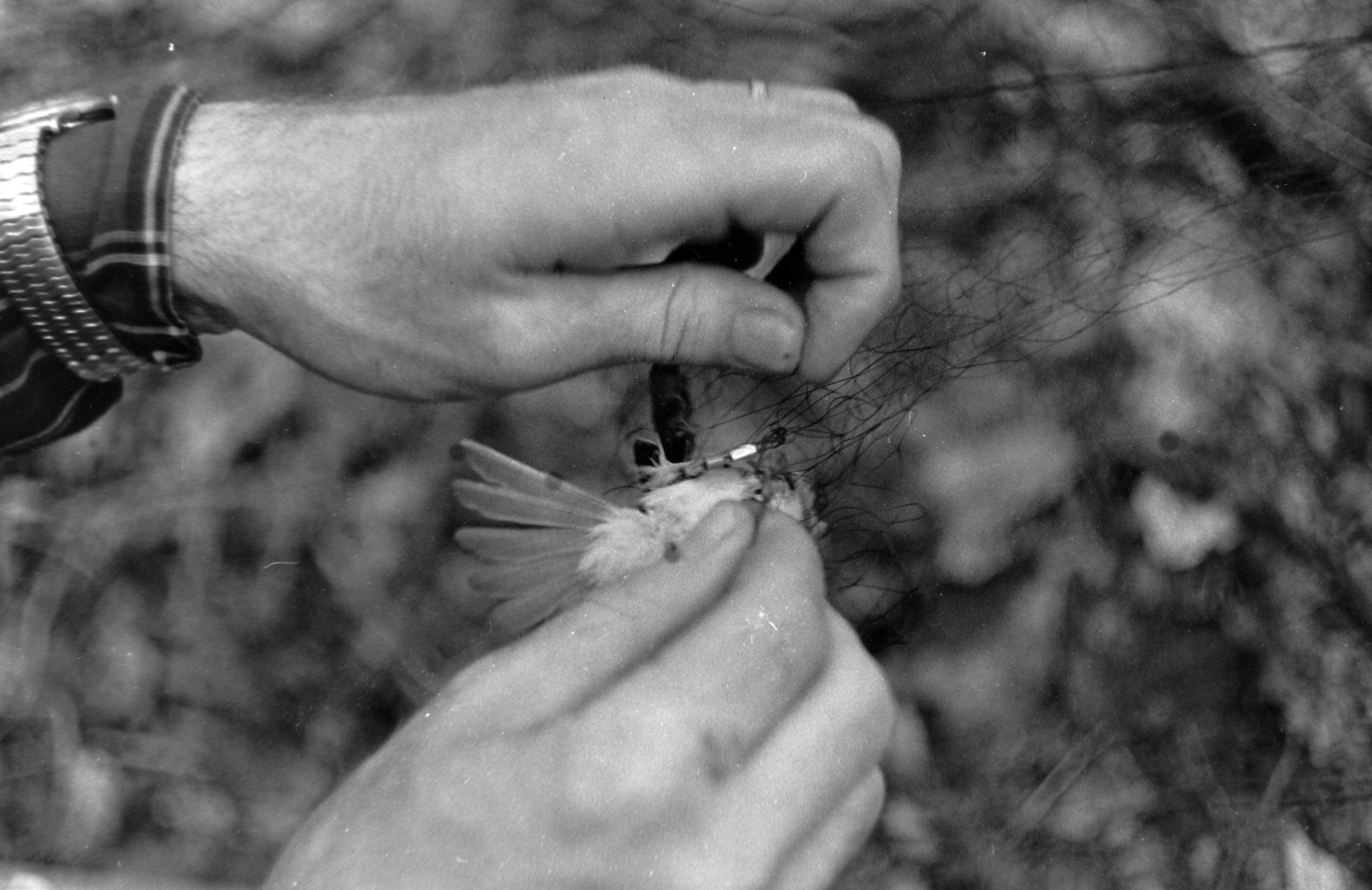
At C-8 Dot found the first bird. Its beak was sticking through a hole in the net. Wings were entangled, feet ensnarled, and the throat snared by the tiny, almost invisible, nylon threads. The net had done its job well. The bird was almost completely immobile, except for its strong, seed-cracking beak which pinched hard on Dot’s finger.
“Ouch,” Dot said, letting go of the bird and puzzling over its species.
Dave got out the recording book, pen, and bands as Dot identified her bird.
The bird had the thick beak of the purple finch but it was half again as large. Turning to the plates showing the finch family in Peterson’s bird guide, Dot decided the bird was a female rose-breasted grosbeak. The other female grosbeak in the picture, with streaked breast and sides, didn’t have so distinct a dark-and-white-stripe pattern across its head. The brilliant rose bib of the male rose-breasted grosbeak gives the species its name.

The delicate job of freeing the bird began. Dot worked the loops of net, now tightly pulled threads, from each claw. She held a freed leg between the second and third fingers of her left hand while her thumb and first finger held the ankle of the other leg. With her right hand she gently pulled thread after thread after thread off each toe. Finally all four toes of the second foot were free too. Grasping both legs gently between her left-hand fingers she pulled the bird away from the netting. But the hooked barbs that join single feathers into one fabric caught the threads and held fast. Patiently, one by one, Dot found each loop and eased it off a feather or over the hard bony elbow and wrist of a wing.
Closing a freed wing against the bird’s body, Dot loosened the second wing. When both legs and wings were free, Dot held the small body gently but firmly enclosed in her hand.
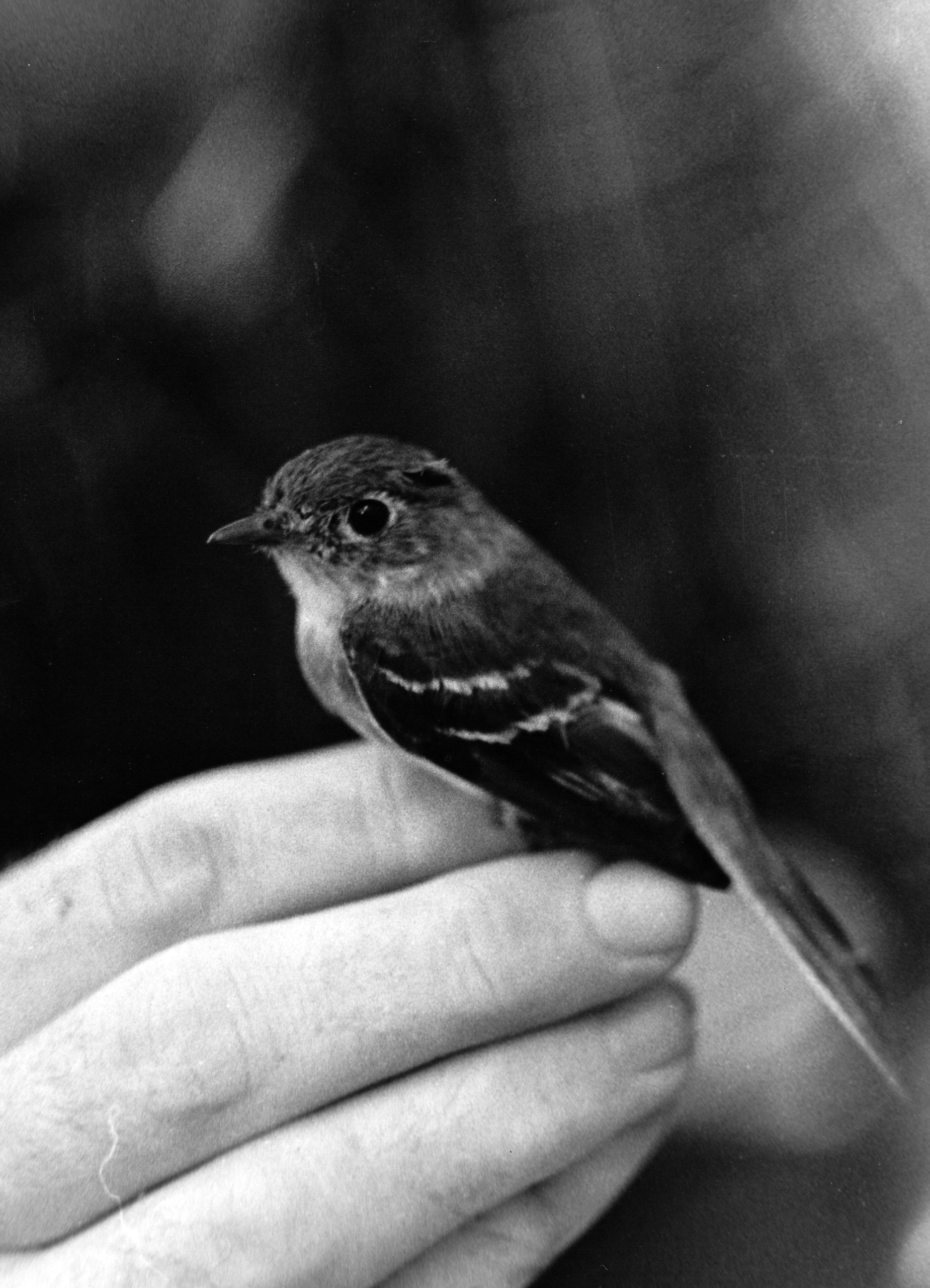
The neck and head must be released before the job would be completed. Dave saw that Dot had a problem. While she had pulled the grosbeak away from the net, the tough nylon threads were tightening a noose around its neck. Harder pulling would strangle it.
Dot knew the bird couldn’t stay there for long, and other birds might need care in the other nets.
Dave said encouragingly, “There have been times when the job was impossible and we’ve had to cut a hole in the net. But usually we hadn’t been able to get this far.”
“Ouch! You stop that!” Dot hollered at the bird.
Taking care to keep her working hand behind bird’s head and beak, Dot gently poked a leadless metal pencil under the neck feathers, seeking the tightened threads. Trying one strand and then another, she found a loose loop and pulled it up and over the head and beak. Other threads followed. Finally only one loop remained caught in the bird’s mouth. Dot poked the mouth apart with the tip of her pencil.
“Look out, Dot. If you pull the thread straight out it will cut the tongue off!” Dave warned.
The bird’s tongue juts up on each side in back. Hooklike pieces of tongue help pull food down its throat. The thread gets caught behind these fleshy barbs. If a birder should pull, the thread would cut the tongue.
“Push the thread backward into her mouth. Back, up, over the top of the tongue and out,” Dave suggested.
Free at last. What a relief!

Dave fished a small child’s sock from the blue binder that held all the banding and recording materials. He took the bird from Dot, deftly sticking its beak into the sock toe and enclosing the rest of the bird in the tiny sock. Only the tip of its tail was visible. Now the bird wouldn’t fuss and could be handled easily.
Dave reached for his notebook and took out a pocket-sized scale that looked like a first-grader’s big round green pencil. He clipped a top edge of the sock to the bottom of the scale. The bird dangled while a small marker jumped up and down, finally stopping at 49. “Forty-nine grams,” Dot read.
Dave had already recorded the location, date, hour, net number, and weather conditions. Now he entered the bird’s weight on the record sheet.
In the bag Dave located his pliers. Especially made for bird banding, the pliers had doughnut-like holes in the middle of the jaws and near the tip. Next, Dave took out silver-colored metal bands. Like wide silver bracelets in various sizes, the band snugly ringed very small, small, medium, large, and very large bird legs. Last came colored bands, bracelets made of plastic: red, orange, black, blue, and white.
“Take a number 1A off the wire ring. That should fit this leg,” Dave told Dot. “Now read the pressed out numbers on the metal Government band.”
Dot squinted to make out the raised numbers.
Dave recorded the number next to the bird’s name on the banding sheet. Then he turned to the list of birds for possible color combinations. “Remind me to cross off the colors I use. Otherwise two birds of the same species will be flying around with the same colors and confuse us.”
Each color-banded leg marked an individual bird that the birders could identify by sight. Colors easily recognized by the naked eye or through binoculars had been chosen.
“We’ll use orange over white.” Dave selected from the list of unused color combinations.
Dave removed the scale and placed the grosbeak on his knee. He gently unrolled the upper part of the sock down over the belly, turning the bird so that its right side matched his own right side, its left side matching his own left side.
“This year we’re putting the metal bans on the right leg,” Dave reminded himself and Dot. He slipped the bracelet around a metal pin on the closed pliers. When he opened the pliers the pin parted, opening the band a little. Then he placed the opened metal band in the pliers’ larger round hole and slipped it around the bird’s right leg above its ankle. Now he held the leg against the inside of the band so it would clear the spot where the two sides of the band would come together. He squeezed the pliers, closing the silver metal bracelet around the bird’s leg.
Next the bird got an orange band on top of a white band around its left leg. A tiny “shoehorn” slipped these bracelets on easily. Dave crossed off “o/w” under the rose-breasted grosbeak list.
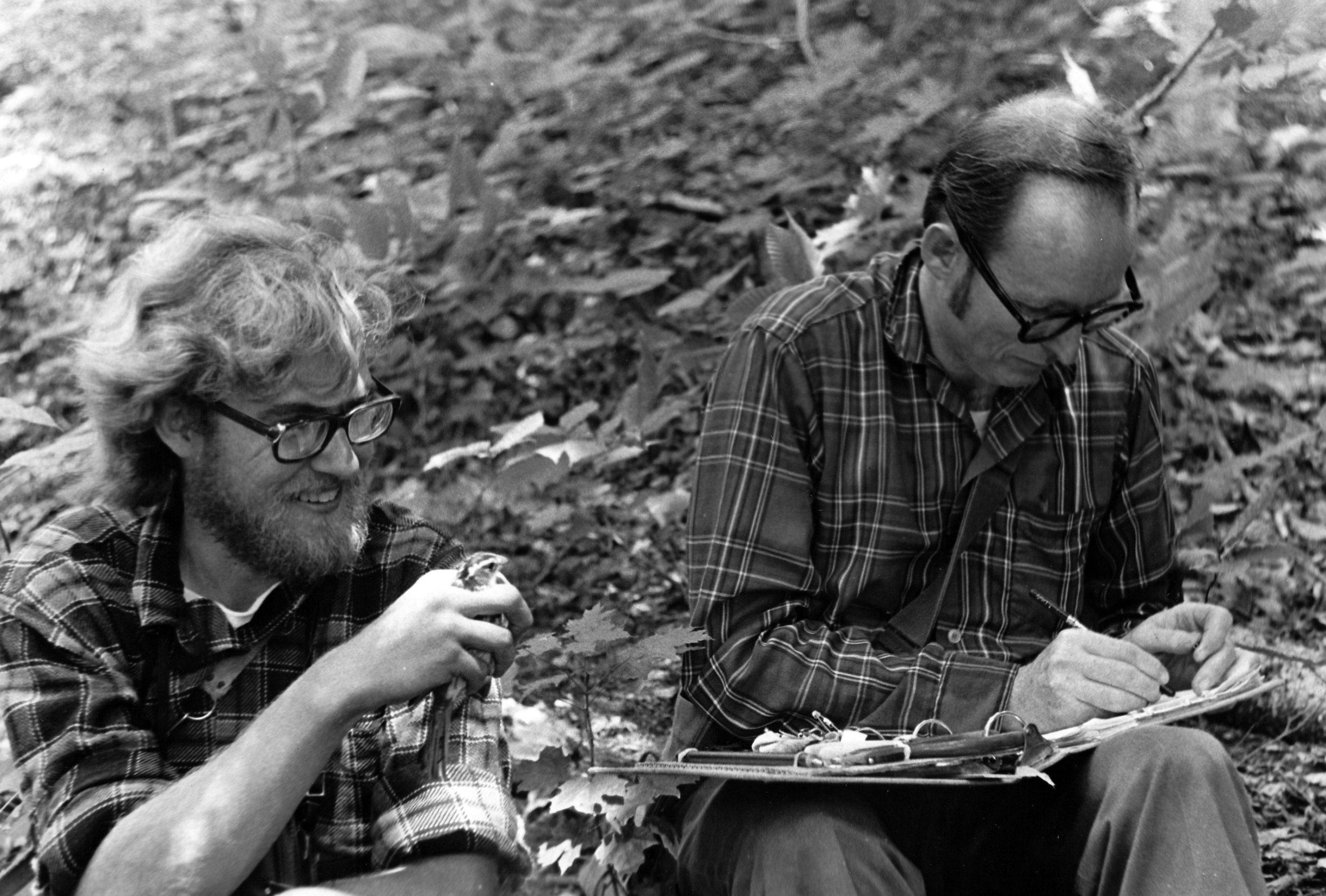
Before setting the grosbeak free, Dave blew up the downy feathers on the bird’s lower breast. Dot, looking closely, saw a naked reddish patch under the feathers.
“The brood patch. This female is raising young.,” Dot reported.
If the sexes of a species have the same color plumage, it can be difficult to determine whether the bird is a male or a female. At this time of year finding a brood patch helped identification.
“Fat O, Zero,” Dave said, looking at the absence of fat under the bird’s skin.
Dot recorded these facts. With all the information noted, Dave rolled the sock over the bird’s breast, throat, and beak just as you would roll your own sock off your foot. He clapped his hand over its wings and gently turned it over onto its feet. Resting it on his open palm, Dave took his hand away. In an instant it was gone, flying easily and freely down the hill away from the net.
With his notebook back on his hip, Dave straightened the net, readying it for the next birds. Dot was already sprinting to the next net. She was eager to find what new bird might be waiting for them.
The grosbeak, with her two sets of bracelets, was now part of both the U.S. Government’s and the researcher’s banding systems. Anyone finding her could read her number, send the number to the U.S. Government, and discover when and where the bird was banded plus other places it might have been captured. The ornithologists had received permits from the Government to capture and band. They reported each bird banded, with its number and other relevant information, to the U.S. Migratory Bird Laboratory at Laurel, Maryland.

This method of tracking birds is the way migration routes and some of the habits of birds have been discovered. The Hubbard Brook researchers always wondered whether anyone in South America would find some of Hubbard Brook’s birds. Dave had already been excited and amazed by finding repeats from the previous year’s banding. One small vireo had traveled 7,200 miles in nine months – one of nature’s regular miracles.
Banding would tell the ornithologists a lot. Dick and Frank and the crew could watch color-banded birds through binoculars and learn how much the birds moved about, what they did, and where their invisible boundary or territory lines were. By watching the plot all year they would learn which birds were permanent residents and which ones were seasonal visitors.
On the morning of our story Frank was having a slow session. He had made his round twice, but he had netted only one bird. At A-1 his two daughters joined him. Karen’s eyes searched back and forth from the top sections to the lowest pockets of netting. She walked along the net, pulling up the bottom section to better see the pocket near the ground. Midway the net appeared to be caught on a twig. Bending to release the strand, she discovered, instead of a twig, a tiny black-throated blue warbler with its blue-gray back. Its brilliant colors identified it as a male.
Karen pulled open the pocket, putting her right hand over the quiet body. The short, narrow beak stayed closed. The bird lay still. Working carefully, Karen removed strand after strand, freeing legs, body, and head. The netting that had slid smoothly off the body feather became anchored in primary and secondary wing feathers. Using a fine mechanical pencil, she worked the net over each feather.
As she held wings against body, the net pulled easily off the short head feathers. When she opened the beak, the net fell away completely.
Karen relaxed her hand an instant. The bird took the moment to grab for freedom, flitting out of her grasp and right back into the net.
“Oh, no!” Karen groaned. “We have to do it all over again.”
“That happens,” Frank said. “Don’t get frustrated or discouraged. Just do it again.”
This job taught patience. In a short time Karen slid the bird into a sock.
Sheryl opened the permanent-black India-ink pen used for official scientific data recording. Once dry, the ink is waterproof and won’t wash away in the rain. Notebook opened on her knees, she recorded as her dad called out the information: “Second bird, June 30, 8:30, A-3, BBW, Male, blue over orange, number 12345-67899, age: AHY (after hatching year).” Hooking the bird on the scale, Frank took off 5 grams for the sock’s weight and Sheryl recorded 10 grams. She marked off the blue-over-orange combination on the sheet
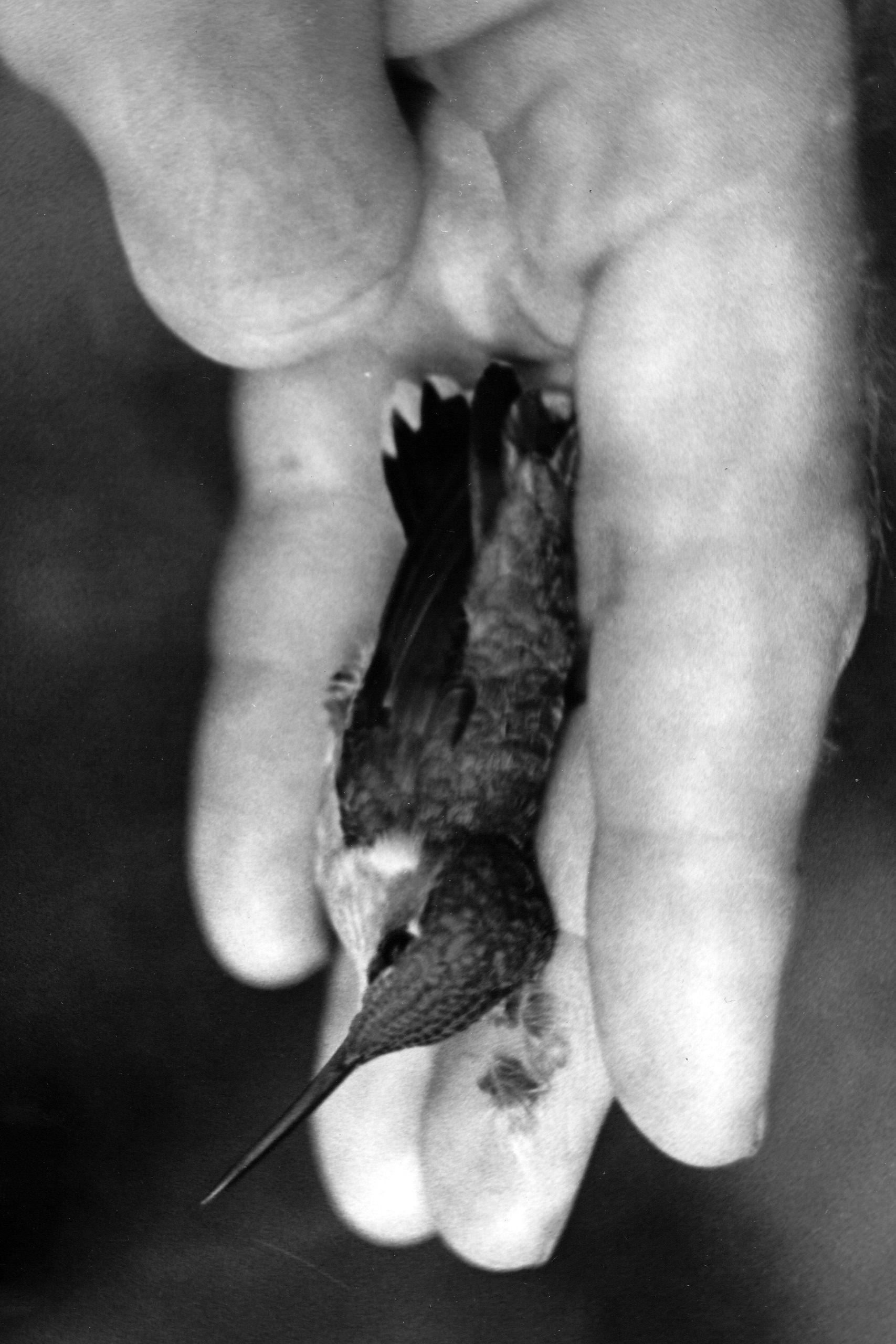
“Done,” Frank said, putting the newly banded warbler into Karen’s hand.
She held the bird in her open hand next to the net pole. It waited, not moving. Feeling no restraints, it suddenly darted down and then up to a high limb, paused, and flew out of sight.
Energetically they tramped from one net to the next. Sometimes all three worked to extract birds and “sock” them until their records could be taken. Sometimes the net was empty. After several empty nets and one female scarlet tanager, they came to repeats, two redstarts that had already been banded. Black-hooded with bright red along the leading edge of a wing folded next to a pure white breast, the redstart had large white dots on the underside of its black tail plus outer tail feathers that flicked yellow when the bird was on the move. Appearing at first like a small junco, its quick movements and flashes of red and white gave it away as a redstart.
Frank marveled at the engineering and design that gave these small birds such fantastic flying power. Each bird, only nine grams of flesh, bone, and feathers – no heavier than a letter you’d slip into a mail slot – travels thousands of miles to the Amazon basin in South America. And it comes back again, one round trip every year. How does it make it over those wide spans of water? It can’t rest or eat. How can it package enough energy for the trip? How does it store and use its food? Even biochemists don’t know the answers. There are still a lot of bird mysteries to be solved.
Sheryl and Karen looked down with respect at the piece of life in their hands. They enjoyed its colors and deeply admired the life force that permitted the redstart its fantastic feats.
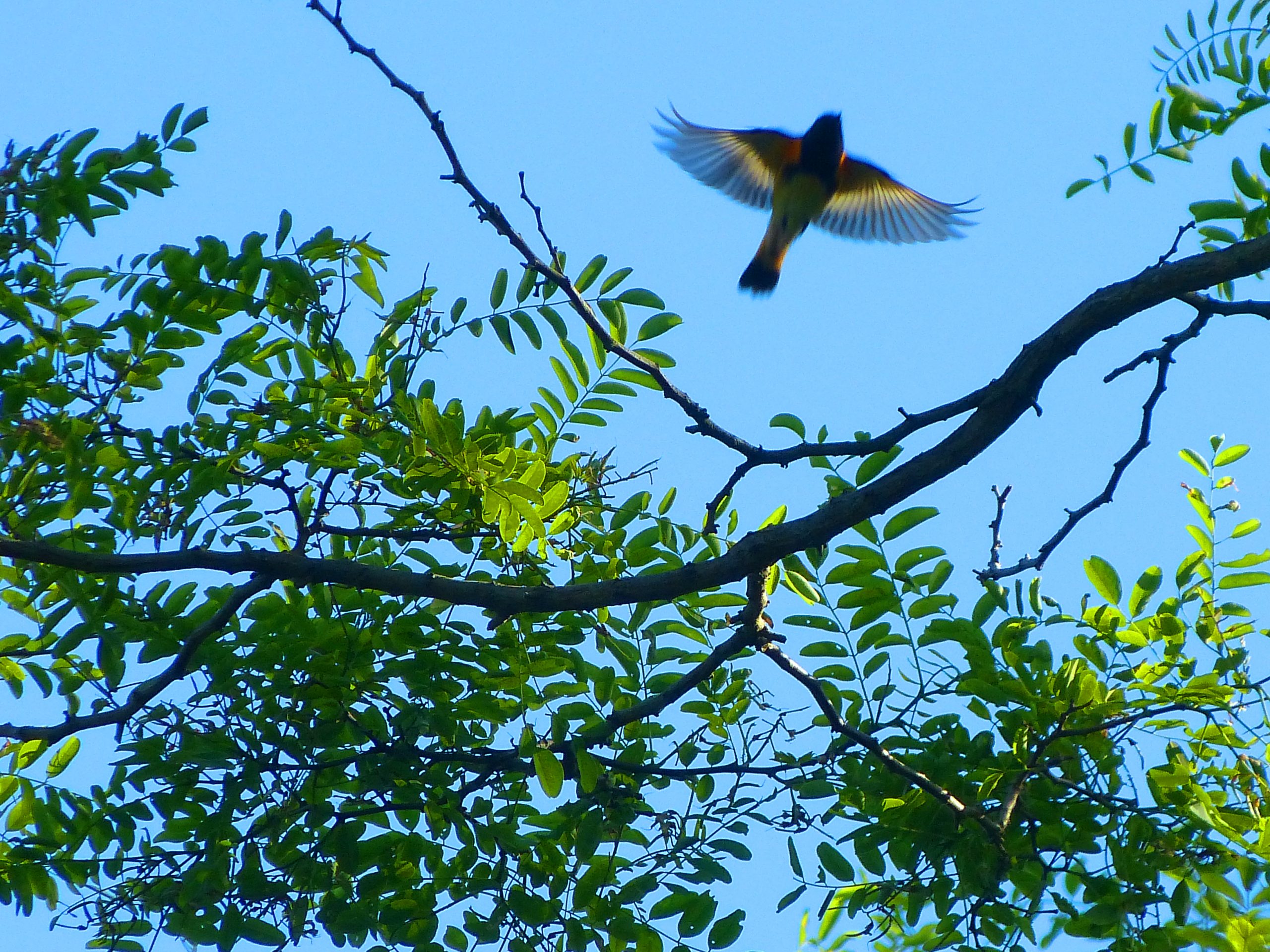
Frank was recording each bird in his journal. Over his shoulder Sheryl could make out his cramped inked notes: “6/30/9:30 A.M. A-10. Breeze slight, 5mph from W. Sky: clear, few stratus clouds. Air temp: 70 degrees. Two male redstarts in net. Repeats: Rt.”12345-67879 male, w/r ASY, and Rt.#12345-67849, o/y male, ASY (after second year). Toward B-9 hear ovenbird, male. Toward A-5 hear wood thrush. Down slope hear vireo.”
Closing his journal, he turned to the repeat sheets in the notebook. After recording the numbers, colors, and weights of the two birds beside the date, time, and place, he was ready to go on to the next net.
Why hadn’t the girls heard the birds that Frank had just listed in his journal? How did he know he had heard a thrush or an ovenbird? Any bird watcher can tell you that it is not easy to identify songs and calls at first. You have to practice. It helps to have someone point them out to you. Before long you will recognize a few birds. Find a bird singing or giving forth a call note. Then watch and listen at the same time. When next you hear its song or call note, you will remember the song coming from the bird you watched. It is a matter of association. Stop, look, listen!
As Sheryl listened to a calliope of whistles and songs up the slope, Frank pointed out each time two notes repeated themselves. A high note was followed by a note several steps down the scale. “Does tea-cher, tea-cher, tea-cher fit the pattern you’re hearing?” he asked.
Listening closely, Sheryl finally fitted the word to the notes. While she listened, Frank pointed to a smallish orange-capped bird in his bird book. Light olive-brown on top, it had a white breast streaked with brown. Its common name was ovenbird, a kind of warbler.
Seiurus aurocapillus is the ovenbird’s scientific name. The first name is called its genus – like your surname. The second, aurocappillus, is its species name – like your first name. In Latin, seiurus means “shake.” The ovenbird pumps its tail up and down. The species name, aurocappillus, means orange cap and further described the ovenbird. The bird’s nest does look like an old-fashioned earth oven. It is a small rounded dome of leaves and bark on the ground with a doorway the bird can creep into.
Latin is used to name birds as well as plants and other animals, because science tries to be as exact and specific as it can when naming or measuring. These are two of the goals of science: to be exact and to be specific. There might easily be several birds in the world that make nests resembling ovens, or many birds with orange caps. Local people might name a common bird “ovenbird” or “orange cap.” But it wouldn’t necessarily be the same bird as this ovenbird. If you were visiting and discussed the ovenbird, each person could be talking about a different bird. Information you exchanged about the bird’s song, food, behavior, and habitat wouldn’t be accurate, because you couldn’t be sure you were talking about the very same kind of bird.
Latin has the advantage of being a “dead language.” Not used by any people in daily life, it does not change. Latin words are not getting new meaning or losing old meanings. Fifty years from now a Latin description will mean the same as it does today. An English or French description may not. Since no species of plants or animals have exactly the same Latin names, there are no duplications. When Frank says he saw a Seiurus aurocapillus, the same bird appears in every ornithologist’s mind.
At B-8 Dave and Dot appeared fifty meters above them. Frank shouted, “How’s it going?”
“One sapsucker, one grosbeak, four least flycatchers, two redstarts, and a Swainson’s thrush. Pretty low for three hours. What about you?” Dave shouted back.
“A little slow too. One BW, an OB, two RS, a HT and WT and a tanager. Looks like a PF here,” Frank answered. The PF meant purple finch. Between themselves the birders used the initials of the common names for the birds found in this forest. It was a type of oral shorthand. The scientific names in Latin appeared in all their written reports.
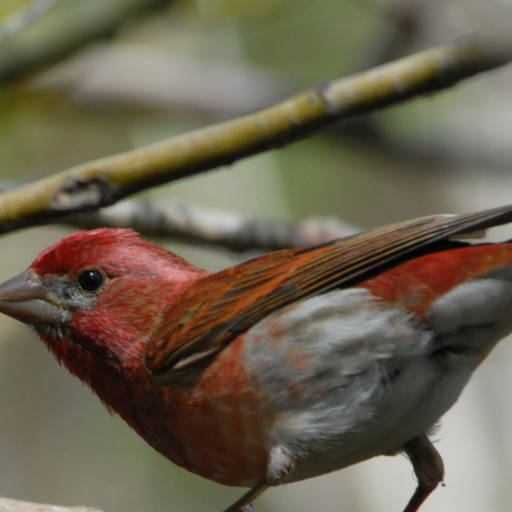
Sheryl and Karen were soon at A-2 again. Quickly scanning the net, they pulled the bottom free. Toward the end a chipmunk scampered away from their feet. Looking down, they recognized another redstart, a mass of blood and feathers. Caught low to the ground, the redstart had become prey for a predator, the chipmunk.
Frank took notes, adding “dead” to his records. The other forest animals would reorganize the redstart’s materials and energy. Nothing is wasted in a well-balanced forest. But this fact was small comfort to the saddened trio. Researchers always try to minimize the upsetting effect of their own presence or research procedures on the natural community they study. But sometimes their efforts are frustrated, as in the case of the redstart. Without the net, the bird would have escaped this predator.
The rounds went faster as the sun rose overhead. Bird activity had lessened – there were fewer captures. Legs tired, the girls left Frank near noon.
To make the early morning census, Tom and Dick split the plot in half. Tom walked along B line and Dick walked parallel to him on D line. They could see and hear fifty meters on each side of their lines. Their sightings might overlap on C line, but later they would compare their notes, eliminating from one of their maps the duplicated birds. Proceeding at a rate of six minutes between each net they stopped to listen, observe, and record the species and individuals of birds they saw or heard. They recorded on the map of the plot the approximate location of each song heard and each bird seen.
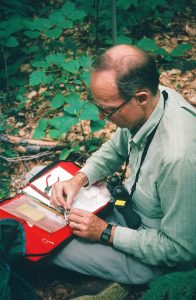
After completing the morning census, which took an hour, Dick hiked to his net below A line, while Tom continued to wander and map at random the activity he observed and heard anywhere in the plot.
Using binoculars, Tom checked the legs of birds for color bands. He recorded in his journal each bird he saw and its colors, as well as marking the colors and location on his wander map. Tom’s work this day would result in more dots on Dave’s larger species maps. At the end of the summer a line encircling the sightings would reveal each individual bird’s territory.
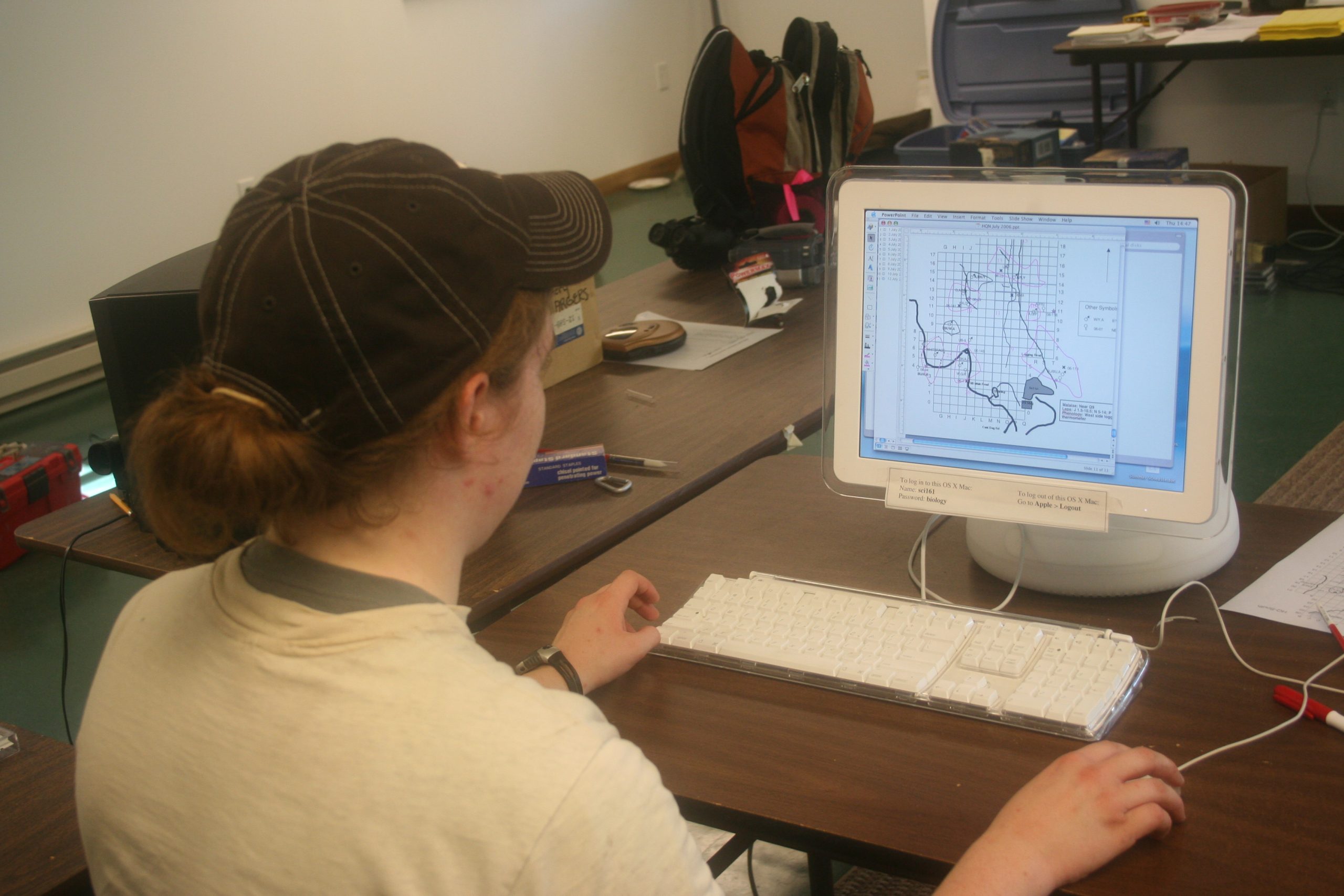
From April through July male birds establish and maintain territories and sing their identifying songs for the females to hear. The songs are bold declarations of ownership. The “keep out” feeling is strongest toward other birds of the same species.
Even though a bird and his nest takes only a small space in the forest or any other habitat, the bird needs more space – a larger territory – for feeding. A dependable feeding area is necessary to a pair of mated birds raising young. If a bird can keep other birds who compete for the same food out of his territory, he has a better chance of getting enough food for himself and his family. Like a dog, a bird defends his territory.
As Tom walked along that morning, he noticed a bird poised on the outer tip of a twig high above his head. The bird suddenly darted out from its watching post, swooped down to snatch a fly on the wing, and circled back to its branch.
Tom knew that flycatchers don’t mind nuthatches, woodpeckers, or sapsuckers who use their specially shaped beaks for getting insects from under the outer bark of trees. The seed eaters, with conical beaks, that stay on the low shrubs and ground don’t bother a flycatcher either. But this flycatcher had driven all the other fly-catching birds out of his private feeding ground. Even though no one could see a boundary line or fence, the flycatcher knew his lines and would fight to defend them. A fight to the death or until blood was drawn could happen, but usually didn’t. The owner of a territory is often the bolder and more aggressive bird.
Puffing up to look larger, spreading and fluttering his wings, the flycatcher dove toward another flycatcher who had stopped below him on his tree. Making his beak into a spear, the “owner” of the tree started dive-bombing the invader, while snapping his beak loudly. The intruder flew off, discouraged. He would find another territory with no resident flycatcher.
The closer the time to nesting, the more pugnacious a bird becomes. Once nesting begins, any bird or animal might be attacked if it ventures too close to a nest. Birds will use clever ruses to attract predators away from their nests. Adult birds can be very tricky. Have you ever been led down a hillside by a bird with a broken wing, only to have the bird fly off, leaving you to watch it disappear over the hill?
Tom peered into the hobblebush under an orange tag on a nearby tree. A small, narrow, shallow nest was attached loosely to the stems of the vine. Filling the space were white eggs speckled brown. Dave had found and tagged this nest after he had seen the mother bird fly out of it. If the eggs hatched, the nest would be observed and the number of feeding trips counted. If the researchers were lucky enough to band the birds, the crew could discover whether the fledglings returned to the plot of their birth after migrating.

Nestled in a branching V, shredded birch bark loosely formed a nest that held eggs in a smooth cup at its center. In thirteen or fourteen days, the incubation period, young, naked, blind hatchlings would cry dependently for food.
Tom S. pushed the record button on his tape recorder. “West plot, 2:15 P.M., June 30. Red-eyed vireo nest in D-10. Female sitting; male on branch. Male: step, step, rest. Hop, hop, hop 12 inches, rest; three hops 18 inches. Male flies 15 feet to branch. Rest. Flies thirty feet horizontal; flied ten feet down slope; turns, rest, 3 hops 12 inches. Male flies directly to nest. Rest. Flies up 10 feet. Rest. Hop, hop, hop…” Tom recorded everything the bird did in minute detail, letting his tape record the time spent at each activity. The female flew off her nest, hovered in the air, grabbed a caterpillar from a leaf, landed, and whacked that caterpillar to death on a branch. All the activity was recorded.
Back at the house, when the tapes were transcribed, the time involved in all the various activities would be tallied. The energy required for each of the activities could be calculated. Then an estimate of the energy used by the birds on an annual basis could be made and compared to the total light energy captured by forest plants, the producers.
Tom met Dick at the truck. Dick had captured a red-eyed vireo and a black-throated blue warbler. The birds rested quietly in two green net sacks closed by drawstrings.
“We’ll see what they’ll eat in captivity,” Dick said.
The oxygen consumption of live wild birds needed measuring. Not much information has been recorded about the metabolism of wild birds. In a special glass-enclosed cage at the college the energy wild birds use at rest and when they’re active could be measured.
The bird banders closed the nets and met Tom and Dick. It was three thirty P.M. when they drove into the driveway of the farm.
After a swim in the cold lake and dinner, the record-keeping began. Dot recorded each capture on a “3 x 5” card kept for each individual bird. The card showed all the places that one bird had been caught. Some bird cards were filling up because some birds got caught a lot.
Dave plotted on his special map for each species the locations of the birds observed during the censusing and wandering. He identified each individual symbolically by species, color bands, sex, time, and activity. Near the end of the summer, territory lines would be plotted for each bird.
Dick and Frank discussed the day’s records and tried to figure out how many mated pairs were nest-building.
The crew enjoyed being in the field looking at birds. The nights and rainy days spent bookkeeping seemed more like work. But one of the main differences between bird watchers and research ornithologists is organized and consistent record-keeping. Eventually, the ornithologists would figure out the general picture from the little bits of facts that were gathered each day.
Bedtime arrived all too soon after the 10 P.M. weather report.
Rain was predicted, so the birders could sleep late – until 8 A.M. They would catch up on their record-keeping the next day.
UPDATE: SOME ANSWERS AND MORE QUESTIONS
After 30 years of record-keeping, Dick, Tom and other researchers have been able to answer some of the questions they set out with and came up with new ones. One of the questions was how the bird populations changed over time. The researchers found variations in the numbers of the different species of birds over the years. Numbers changed greatly from one year to the next, sometimes going down and sometimes going up. For example, they found that in general, increases in bird populations seemed to be related to El Niño, a major weather pattern off the western coast of South America.
The long-term trend after 30 years, however, was a declining population. The total number of birds went down by over 60 percent, from 215 birds per 10 hectares in 1969 to 80 birds per 10 hectares in 1998. Of the 24 species found in the Hubbard Brook Experimental Forest, half had much lower numbers in 1998, and 4 of those were no longer found at Hubbard Brook. A few species, however, had greater numbers, and some stayed about the same. So the researchers found out that over time there was a sharp drop in the total number of birds in the forest.
Their new question was why that happened, and why the number of some types of birds decreased and not others. Possible answers included the change in the structure of the forest or changes in the availability of food, or even things that might be happening where the birds spent their winters. The forest structure changed because as it matured, some types of trees and plants prospered and became more numerous, and some species decreased. Bird species which preferred to live in the trees and plants that were disappearing from the forest also were counted less frequently, or even disappeared from the forest.
The types of birds whose numbers declined the most were the migratory birds. The specific species that declined also tended to be the ones that preferred the way the forest used to be before the forest structure changed. Another possible cause for decreased bird counts that was suggested was that increased storms or reduced habitat in the wintering areas could mean that fewer migrating birds survived the winter to be able to return to Hubbard Brook in the spring and summer.
Another question that the scientists started off with was whether bird populations control the number of insects or if insect populations control the number of birds. This seemed to be fairly well answered by the pattern of fluctuation or change in both the insect and bird populations. Researchers found that when there were increases in the numbers of caterpillars, there was a later increase in the number of birds. In other words, when the birds had more to eat, they had more young that survived so that bird populations increased. The scientists found, for example, that there usually were more caterpillars during a certain part of the El Niño weather pattern than in others, and it was during this time that the number of birds also increased. It seemed that events as far away as the west coast of South America could affect the number of caterpillars, and the birds that depended on them, in a forest in the northeastern United States.
